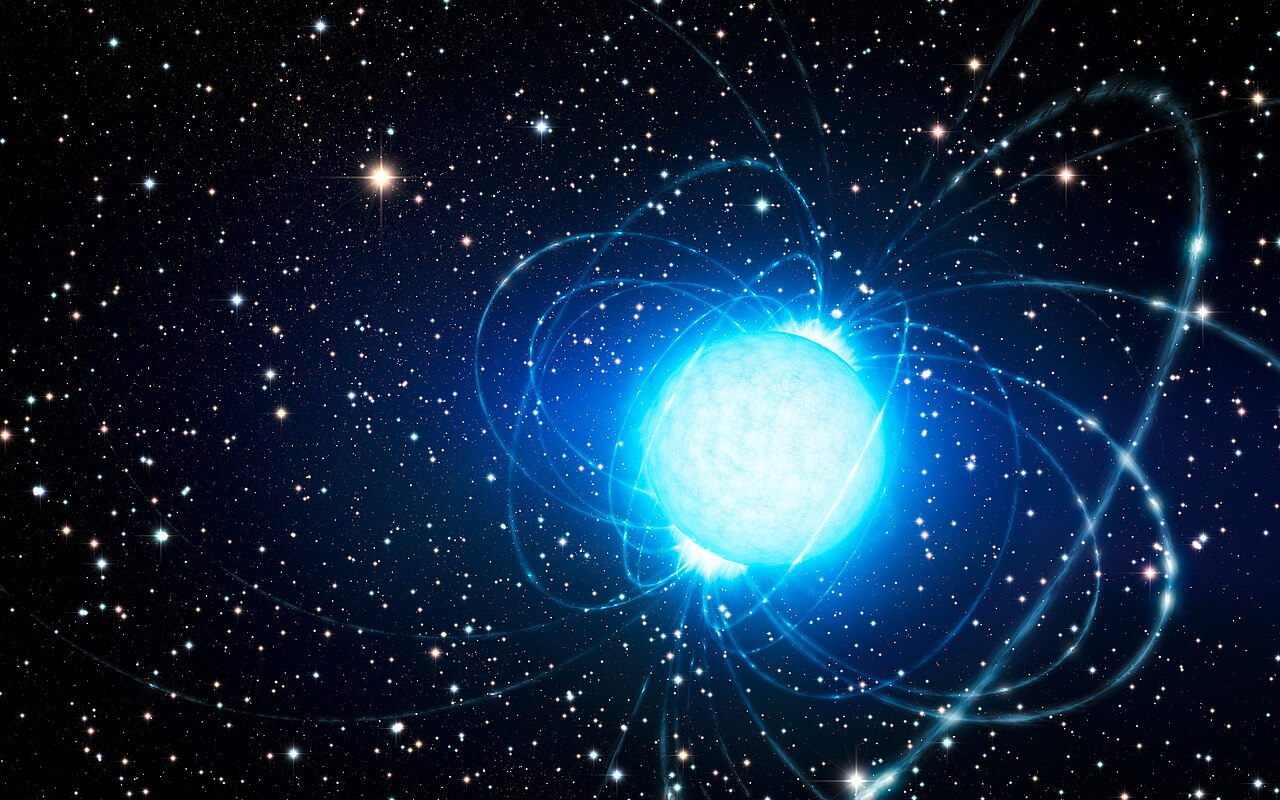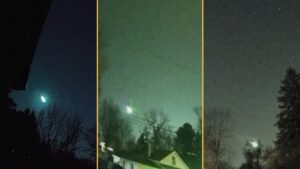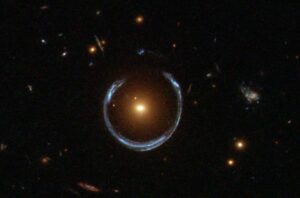We know more about the universe than many people think.
Space mysteries are usually quite mundane to all but obsessive researchers. The most compelling open question in astrochemistry, for instance, is how often molecules are recycled during star formation before depositing onto the surface of planets. It’s a key gap in our understanding of outer space environments, but it’s not going to intrigue any first dates.
But there are a few tantalizing questions that are so big we can’t even tackle them head-on. Questions that most astronomers hope against hope will be answered in our lifetime — but deep down don’t believe ever will be.
In this new series, we’ll cover some open questions in astronomy, starting relatively small and working our way up. This week: the mysterious, sometimes-repeating extragalactic signals known as Fast Radio Bursts.
An accidental discovery
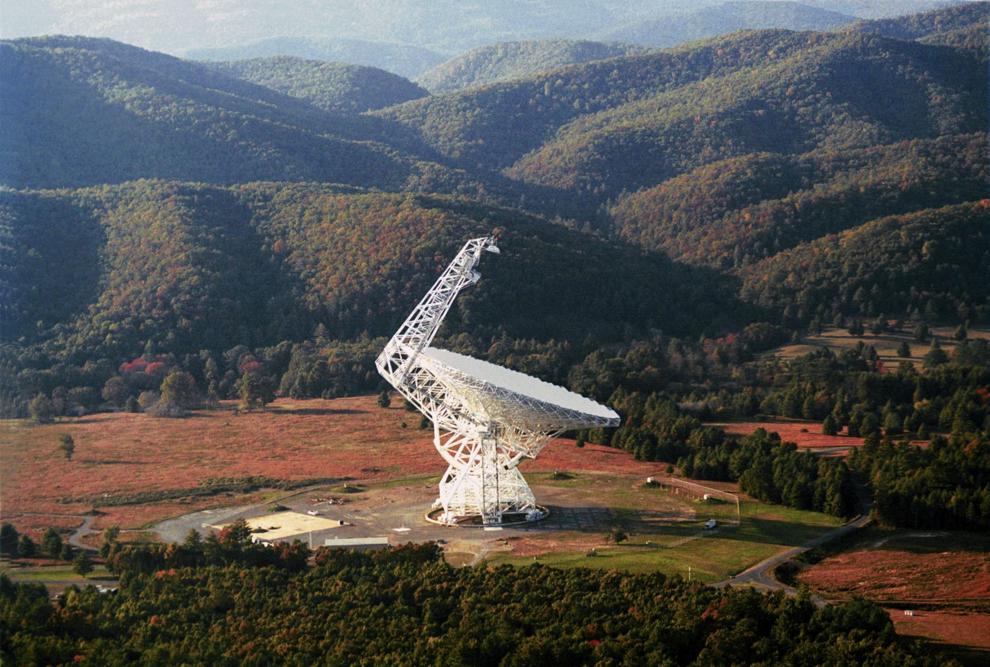
The Green Bank Telescope in West Virginia has helped foster a vibrant radio astronomy community at West Virginia University. Photo: NRAO
In 2007, a grad student at West Virginia University — arguably the center of American radio astronomy — found a strange whooping signal in old telescope observations. It started at high radio frequencies and, over the course of half a second, swept down to low. Then it disappeared.
The high-to-low-frequency aspect wasn’t a mystery. That sweeping pattern appears all over radio astronomy because the free electrons floating around interstellar space slow down low-frequency light more than high-frequency light. Since it gets delayed more, it shows up at the telescope a moment after the high-frequency parts of the signal.
We see this all the time in radio signals from within the Milky Way. We know about how many free electrons there are floating around in our galaxy and how much they delay different frequencies of light. Therefore, the degree of delay from electrons is often used as a rough measure of the distance of an object.
The signal that grad student Ash Narkevic had just found was so delayed that it could only have come from another galaxy.
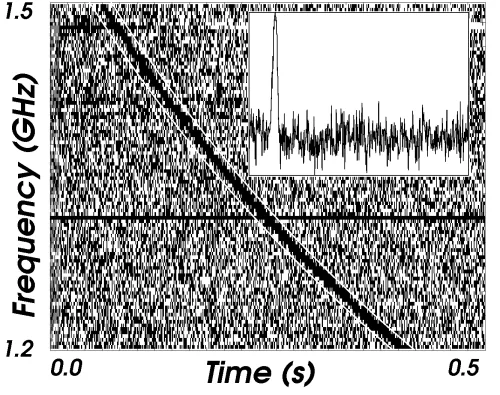
The first detected Fast Radio Burst. The inset at the top right shows the average power when corrected for the time delay between the top and the bottom. Photo: Lorimer et al 2007.
The Lorimer Burst
Narkevic’s advisor was an up-and-coming professor of transient radio astronomy named Duncan Lorimer. He and Narkevic wrote a paper about their discovery, submitted it to the prestigious journal Science, and were soundly rejected.
They resubmitted. This time, their paper was accepted. The world of radio astronomy collectively lost its mind and began pouring over archival data, searching for similar bursts.
They found nothing. In fact, they found worse than nothing. In 2011, after four years of radio silence, a graduate student at WVU named Sarah Burke-Spolaor found a signal that looked uncannily like Lorimer’s burst. She called it a peryton. The trouble was, it was so bright that it could only have been produced on Earth. Had the Lorimer burst, fainter though it was, also been created on Earth?
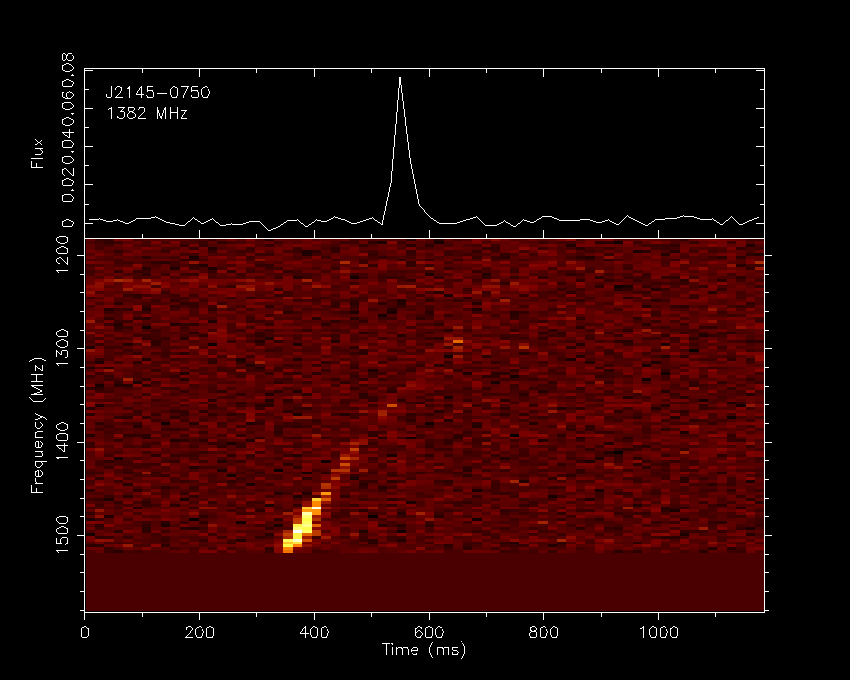
A peryton looks nearly identical to a Fast Radio Burst but too bright to be created off the Earth. Photo: Wikimedia Commons
Furbies
The mystery remained for another two years until a PhD student at the University of Manchester named Dan Thornton turned his eye to a set of data with very precise time information. His search found four more bursts just like Lorimer’s. The bursts were real, and at the suggestion of the Manchester team, they earned a name: fast radio bursts, or FRBs.
There was some early discussion on whether this should be pronounced “furbies,” but the consensus was that this would make radio astronomers look silly. And FRBs are very serious indeed.
Microwave oven?
With new advances in observing using very precise time-processing software, the FRBs started pouring in. The one found by Ash Narkevic in 2007 hadn’t traveled far compared to some of the new FRBs. One of them seemed to have been created 7 billion years ago.
But a specter hung over FRBs. The too-bright peryton signal found by Sarah Burke-Spolaor still lurked in the backs of everyone’s mind, taunting them with the question: If these things look so similar, and some of them are definitely terrestrial, are all of them?
Then, in 2015, an experiment at the Murriyang radio telescope in Australia vindicated FRBs. Swinburne University graduate student Emily Petroff, long obsessed by the puzzle of perytons and FRBs, published the solution in probably the funniest non-joke paper ever written in radio astronomy.
The existence of obviously terrestrial perytons “had previously cast a shadow over the interpretation of [FRBs], which otherwise appear to be of extragalactic origin,” she wrote. “We have identified strong out-of-band emission at 2.3–2.5 GHz associated with several peryton events. Subsequent tests revealed that a peryton can be generated at 1.4 GHz when a microwave oven door is opened prematurely, and the telescope is at an appropriate relative angle.”
FRBs had nothing to fear: “We furthermore demonstrate that the microwave ovens on site could not have caused [the Lorimer Burst].”
The identity of perytons is a continued point of amusement among radio astronomers, and was even parodied in an xkcd panel.

The caption on xkcd for this comic reads: “Dr. Petroff has also shown that the Higgs Boson signal was actually sparks from someone microwaving grapes, the EHT black hole photo was a frozen bagel someone left in too long, and the LIGO detection was just someone slamming the microwave door too hard.” Source: xkcd
The clues
For once, xkcd made a science mistake. In the comic strip, they describe the origin of FRBs as “stellar-sized objects.” We know this can’t be true. The time between the start and the end of many bursts is so short that light could only travel a distance of ten or so kilometers during them. Since light is the fastest thing in the universe, points not connected by light wouldn’t know to emit at the same time. The bursts, therefore, are created within roughly the distance from Everest to Makalu.
Stars are a lot bigger than that.
Another clue in the FRB toolbox, discovered in 2015: Some of them repeat. The pulses look different every time, but they’re very clearly coming from the same location and the same distance. Many more have only ever been seen once. So unless there is more than one mechanism creating FRBs, they aren’t produced by one-off events like supernovae or two stars merging.
The magnetar explanation
And then there’s the final clue. In 2020, independent teams at Caltech and at the CHIME telescope in Canada both found what looked like an FRB coming from an exotic object within the Milky Way called a magnetar. It was 30 times fainter than the faintest FRB but offered a tantalizing explanation.
Magnetars (Lead image) are the corpses of stars that can no longer support their own weight. Gravity crushes them until their protons and electrons squeeze together to form neutrons. They have massive magnetic fields and regularly send out brilliant flashes of gamma rays and X-rays — high-energy photons that often go hand in hand with radio waves. In fact, the Caltech team found that the magnetar released X-rays at the same time as the FRB-lite.
The mystery
So magnetars produce FRBs somewhere on their surface via hijinks in their magnetic fields. Mystery solved.
Except that picture doesn’t explain many extragalactic FRBs. Gamma-ray and X-ray bursts from magnetars are very rare, so how could so many FRBs repeat monthly or even weekly? And why do some FRBs come from galaxies where we don’t expect to find any magnetars? After all, magnetars are all born early in a galaxy’s life span. They only stay magnetized for about 10,000 years. Meanwhile, an FRB reported just this month came from a galaxy that’s been around for 11 billion years.
At this point, astronomers know only one thing for sure: FRBs aren’t coming from microwave ovens.
Anymore.
